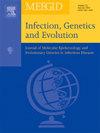利用全基因组测序揭示了韩国具有多重重组的新型GI-19谱系传染性支气管炎病毒亚基因型
IF 2.6
4区 医学
Q3 INFECTIOUS DISEASES
引用次数: 0
摘要
传染性支气管炎(IB)是由传染性支气管炎病毒(IBV)引起的一种高度传染性鸡疾病,在世界范围内造成经济损失。尽管使用了灭活疫苗和减毒活疫苗来预防或控制IBV,但新的IBV毒株和变体仍在不断出现。在这项研究中,对2003年至2024年间从韩国商业鸡群中分离的46株IBV毒株的S1基因进行了测序和遗传表征。IBV分离株属于韩国II群(K-II),属于GI-19谱系。根据系统发育树分析结果和S1基因的核苷酸鉴定,将K-II分为5个亚基因群(a-e)。其中,K-IId是韩国最常见的基因型;同时发现了8株属于K-IIe亚基因型的新分离株。其余4个K-II亚基因型和8株分离株的核苷酸和氨基酸同源性分别为84.42 ~ 95.89%和84.02 ~ 95.86%。采用新一代测序技术获得8株K-IIe分离株的全基因组。8株IBV的S1基因同源性较高,但重组模式不同。8株K-IIe分离株中,6株为重组株,分别为K-IIe与K-IIc、K-IIe与K-IIa以及与活疫苗株的重组。大多数重组断点位于ORF1a、S2和M基因的nsp2区。本研究提出了韩国流行的GI-19谱系K-II的新分类标准,揭示了最近发现的新分离株的重组模式,为新型病毒亚基因型株和IBV进化提供了重要信息。本文章由计算机程序翻译,如有差异,请以英文原文为准。
Revealing a novel GI-19 lineage infectious bronchitis virus sub-genotype with multiple recombinations in South Korea using whole-genome sequencing
Infectious bronchitis (IB), caused by the infectious bronchitis virus (IBV), is a highly contagious chicken disease, causing economic losses worldwide. New IBV strains and variants continue to emerge despite using inactivated and live-attenuated vaccines to prevent or control IB. In this study, the S1 genes of 46 IBV strains, isolated from commercial chicken flocks between 2003 and 2024 in Korea were sequenced and genetically characterized. The IBV isolates belonged to Korean group II (K-II), which was included in the GI-19 lineage. The K-II was divided into five sub-genogroups (a–e) based on phylogenetic tree analysis results and nucleotide identification of the S1 gene. Of these, K-IId was the most common genotype in Korea; however, eight novel isolates belonging to the K-IIe sub-genotype were discovered. The nucleotide and amino acid identities of the other four K-II sub-genotypes and the eight isolates were 84.42–95.89 % and 84.02–95.86 %, respectively. The complete genomes of the eight K-IIe isolates were obtained using next-generation sequencing. Various recombination patterns were observed despite the high homology of the S1 gene among the eight IBV strains. Among the eight K-IIe isolates, six were recombinants, exhibiting recombinations between K-IIe and K-IIc, K-IIe and K-IIa, and with the live vaccine strain. Most recombination breakpoints were detected in the nsp2 region of the ORF1a, S2, and M genes. The present study proposed new classification criteria for the K-II belonged to the GI-19 lineage prevalent in South Korea and revealed the recombination patterns of recently identified novel isolates, providing important information on novel viral sub-genotype strains and IBV evolution.
求助全文
通过发布文献求助,成功后即可免费获取论文全文。
去求助
来源期刊

Infection Genetics and Evolution
医学-传染病学
CiteScore
8.40
自引率
0.00%
发文量
215
审稿时长
82 days
期刊介绍:
(aka Journal of Molecular Epidemiology and Evolutionary Genetics of Infectious Diseases -- MEEGID)
Infectious diseases constitute one of the main challenges to medical science in the coming century. The impressive development of molecular megatechnologies and of bioinformatics have greatly increased our knowledge of the evolution, transmission and pathogenicity of infectious diseases. Research has shown that host susceptibility to many infectious diseases has a genetic basis. Furthermore, much is now known on the molecular epidemiology, evolution and virulence of pathogenic agents, as well as their resistance to drugs, vaccines, and antibiotics. Equally, research on the genetics of disease vectors has greatly improved our understanding of their systematics, has increased our capacity to identify target populations for control or intervention, and has provided detailed information on the mechanisms of insecticide resistance.
However, the genetics and evolutionary biology of hosts, pathogens and vectors have tended to develop as three separate fields of research. This artificial compartmentalisation is of concern due to our growing appreciation of the strong co-evolutionary interactions among hosts, pathogens and vectors.
Infection, Genetics and Evolution and its companion congress [MEEGID](http://www.meegidconference.com/) (for Molecular Epidemiology and Evolutionary Genetics of Infectious Diseases) are the main forum acting for the cross-fertilization between evolutionary science and biomedical research on infectious diseases.
Infection, Genetics and Evolution is the only journal that welcomes articles dealing with the genetics and evolutionary biology of hosts, pathogens and vectors, and coevolution processes among them in relation to infection and disease manifestation. All infectious models enter the scope of the journal, including pathogens of humans, animals and plants, either parasites, fungi, bacteria, viruses or prions. The journal welcomes articles dealing with genetics, population genetics, genomics, postgenomics, gene expression, evolutionary biology, population dynamics, mathematical modeling and bioinformatics. We also provide many author benefits, such as free PDFs, a liberal copyright policy, special discounts on Elsevier publications and much more. Please click here for more information on our author services .
 求助内容:
求助内容: 应助结果提醒方式:
应助结果提醒方式:


